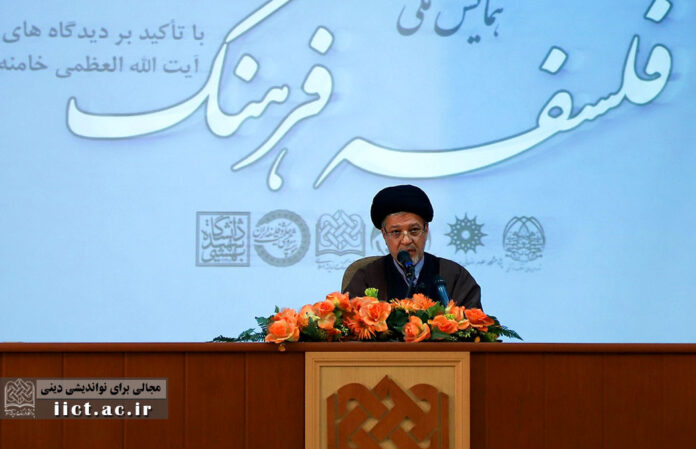According to the Public Relations Office of the Research Institute for Islamic Culture and Thought, coinciding with World Philosophy Day, the National Conference on the Philosophy of Culture—with an emphasis on the views of Ayatollah Ali Khamenei—was held on the evening of Wednesday, November 27, 2024. The event took place in the holy city of Qom, attracting a large number of enthusiasts in philosophical discussions.
Hujjat al-Islam Seyyed Saeed Reza Ameli, former Secretary of the Supreme Council of the Cultural Revolution, began the conference by addressing three dimensions of the essence of cultural philosophy. He stated:
“In the first dimension, we must understand what imperatives Islam envisions for living a meaningful life. From the perspective of Mulla Sadra’s philosophy, the concept of substantial motion plays a role in forming these imperatives.”
He continued by elaborating on the second dimension:
“Culture can be seen as a matter of ‘existence or non-existence,’ which refers to the overall state of being. In a social context, ‘existence or non-existence’ signifies a social presence. General perceptions of culture often reduce it to an issue of ‘presence or absence,’ considering it a social matter. Furthermore, culture is perceived as relative; hence, the social culture of Iran differs from that of Malaysia, Turkey, and other Islamic countries.”
Referring to the eras of the prophets, Ameli remarked:
“In those times, the primary source of culture was religion. However, as centuries have passed and Islamic societies have become entangled with modern life, cultural sources have diversified. In today’s era, two ecosystems are conceivable for culture. It is erroneous to regard the internet as merely a tool; the virtual space has integrated itself into our lives, encompassing every aspect and becoming an ecosystem where everything—from commerce to emotional interactions—takes place.”
He further explained:
“The second space assimilates the first. For example, a phone’s GPS system gathers data from the physical environment and guides us to our destination within the second space.”
The Tehran University faculty member emphasized that many sources of cultural socialization now take shape in the second space. He stated:
“The Supreme Leader has described the virtual space as a ‘slaughterhouse of values’ because many young people learn their socialization through the internet and virtual platforms. Those who adopt stereotyped mentalities exhibit minimal cognitive engagement, merely adhering to preconceived notions. Consequently, religious messaging fails to influence them. In contrast, Western commercial advertising uses persuasion codes to monopolize the audience’s mind.”
He described four phenomena as outcomes of the dual-space nature of culture, stating: “Someone with their feet on the ground and their mind in the virtual space develops a dual tendency. This is because they exist in a local cultural environment while simultaneously living in another space. In this dual tendency, indefinite identities emerge, even though the characteristics of identity are stability and distinction.”
Hojjat al-Islam Ameli continued: “Resistance identities are those that are established and emphasize a particular matter. Eighty-five percent of internet content manifests in images, creating a visual world that shapes perceptions for audiences. The second group comprises hybrid identities, which may lead to indeterminacy. The third group consists of legitimized identities, which align with contemporary trends and adapt to the demands of the times, such as virtual actors who operate according to current patterns.”
He added, “Time in virtual space differs from time in physical space. When time and distribution differ, culture naturally changes as well. If we aim to view this matter as part of a transcendent existence, we must note that a shift is occurring—from hierarchical governance to horizontal governance, from lamenting events to a smart system of action, from discourse-based justice to realized justice, and so on—brought about by this dual-space phenomenon.”




